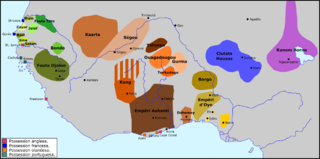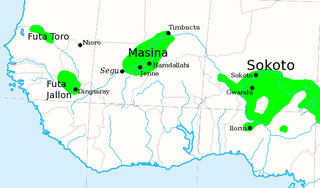
Infantry is a specialization of military personnel who engage in warfare combat. Infantry generally consists of light infantry, irregular infantry, heavy infantry, mountain infantry, motorized infantry, mechanized infantry, airborne infantry, air assault infantry, and naval infantry. Other types of infantry, such as line infantry and mounted infantry, were once commonplace but fell out of favor in the 1800s with the invention of more accurate and powerful weapons.

The Jihad of Usman dan Fodio was a religio-military conflict in present-day Nigeria and Cameroon. The war began when Usman dan Fodio, a prominent Islamic scholar and teacher, was exiled from Gobir by King Yunfa, one of his former students.

The Sokoto Caliphate, also known as the Sultanate of Sokoto, was a Sunni Muslim caliphate in West Africa. It was founded by Usman dan Fodio in 1804 during the Fulani jihads after defeating the Hausa Kingdoms in the Fulani War. The boundaries of the caliphate are part of present-day Cameroon, Burkina Faso, Niger, and Nigeria. By 1837, the Sokoto state had a population of around 10-20 million people, becoming the most populous empire in West Africa. It was dissolved when the British, French, and Germans conquered the area in 1903 and annexed it into the newly established Northern Nigeria Protectorate, Senegambia and Niger and Kamerun respectively.

The Bamana Empire was one of the largest states of West Africa in the 18th century. Along with Kaarta it was one of the most important successors of the Songhai Empire. Based on an earlier kingdom established in 1640, it grew into a powerful empire in the early 18th century under Bitòn Coulibaly. The empire existed as a centralized state from 1712 until the 1861 invasion by the Toucouleur conqueror El Hadj Umar Tall.

Hadji Oumarûl Foutiyou Tall, born in Futa Tooro, present-day Senegal, was a Senegalese Tijani sufi Toucouleur Islamic scholar and military commander who founded the short-lived Toucouleur Empire, which encompassed much of what is now Senegal, Mauritania, Guinea and Mali.

The Tukulor Empire (1861–1890) was an Islamic state in the mid-nineteenth century founded by Elhadj Oumar Foutiyou Tall of the Toucouleur people of Senegal.

The Caliphate of Hamdullahi, commonly known as the Massina empire, was an early nineteenth-century Sunni Muslim caliphate in West Africa centered in the Inner Niger Delta of what is now the Mopti and Ségou Regions of Mali. It was founded by Seku Amadu in 1818 during the Fulani jihads after defeating the Bambara Empire and its allies at the Battle of Noukouma. By 1853, the empire had fallen into decline and was ultimately destroyed by Omar Saidou Tall of Toucouleur.

The siege of Fort Medina took place in 1857 at Médine, on the left bank of the Senegal River in present-day Mali. The Toucouleur forces of Omar Saidou Tall unsuccessfully besieged native and French colonial troops commanded by Paul Holle. After 97 days of siege, a relief force under French Governor Louis Faidherbe lifted the siege and forced the Toucouleur army to retreat.
Tidiani Tall was a Toucouleur leader who succeeded his uncle, El Hadj Umar Tall, as head of the Toucouleur Empire in the former Massina Empire following Umar's 1864 death near Bandiagara.
Sheikhu Ahmadu was the Fulbe founder of the Massina Empire in the Inner Niger Delta, now the Mopti Region of Mali. He ruled as Almami from 1818 until his death in 1845, also taking the title sisse al-Masini.
Amadu II of Massina, also called Amadu Seku, was the second Almami, or ruler, of the theocratic Caliphate of Hamdullahi or Diina of Hamdullahi in what is now Mali. He held this position from 1845 until his death in 1853. His rule was a short period of relative peace and prosperity between the violent reigns of his father and his son.
Amadu III of Masina, also known as Amadu Amadu was the third and last ruler of the theocratic Caliphate of Hamdullahi in the Inner Niger Delta, now the Mopti Region of Mali. He was elected as successor to his father, Amadu II of Masina, in 1853. Throughout most of his rule he was involved in conflict with the jihadist al-Hajj 'Umar Tall, who defeated and executed him on 16 May 1862.

Kaarta, was a Bambara kingdom that arose after the fall of the Songhai Empire in what is today the western half of Mali and lasted until its destruction by Umar Tall in the 1850s.

The Imamate of Futa Toro was a West African theocratic monarchy of the Fula-speaking people in the middle valley of the Senegal River, in the region known as Futa Toro. Following the trend of jihads in the late 17th century and early 18th century, the religious leader Sulayman Bal led a jihad in 1776. His successor, the expansionist Abdul Kader defeated the emirates of Trarza and Brakna and by his death in 1806, power became decentralized between a few elite families of Torodbes. Threatened by both the expansion of the Toucouleur Empire and the French in the mid-19th century, Futa Toro was eventually annexed in 1859. By the 1860s, the power of the Almamy became nominal and the state was further weakened when a cholera epidemic killed a quarter of its population in 1868.

The Fulajihads sometimes called the Fulani revolution were a series of jihads that occurred across West Africa during the 18th and 19th centuries, led largely by the Muslim Fulani people. The jihads and the jihad states came to an end with European colonization.

African military systems (1800–1900) refers to the evolution of military systems on the African continent after 1800, with emphasis on the role of indigenous states and peoples within the African continent. Only major military systems or innovations and their development after 1800 are covered here. For events prior to 1800, see African military systems to 1800. Coverage of the late 19th/20th century and beyond is provided in African military systems after 1900. For an overall view of the military history of Africa by region, see Military History of Africa. See individual battles, empires and leaders for details on activities after 1800.
The Torodbe; singular Torodo were Muslim Toucouleur clerics and theocratic monarchs who preached and reigned in Futa Toro, a region located in the north of present-day Senegal, and other Fula communities in West Africa from at least the seventeenth to the early twentieth century. Drawn from all ethnicites and levels of society, the Torodbe aimed to 'purify' the Islam practiced in West Africa and establish Islamic states run with Islamic law.
The Battle of Noukouma was fought on 21 March 1818 between a small force of jihadists led by Seku Amadu and a Bamana force led by General Jamogo Séri. It was the first and most significant battle of Seku Amdadu's jihad and saw an unexpected jihadist victory against the numerically superior Bamana army. The victory was interpreted as a divine miracle by many and allowed Seku Amadu to rapidly expand his army to over 40,000.
The Battle of Madiongo was fought between in 1827 as part of the Jihad of Seku Amadu. It was fought between the forces of the Massina Empire and troops from the state of Saro allied to the Bamana Empire.











